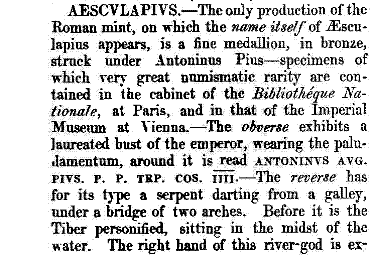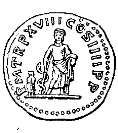AESCVLAPIVS
       | Please |help| us convert the |Dictionary of Roman Coins| from scans to text by typing the original text here. Please add updates or make corrections to the NumisWiki text version as appropriate. AESCVLAPIVS. - The only production of the Roman mint, on which the name itself of Aesculapius appears, is a fine medallion, in bronze, struck under Antoninus Pius - specimens of which very great numismatic rarity are contained in the cabinet of the Bibliothéque Nationale, at Paris, and in that of the Imperial Museum at Vienna. - The obverse exhibits a laureated bust of the emperor, wearing the paludamentum, around it is read ANTONINVS AVG PIVS P P TRP COS IIII. - The reverse has for its type a serpent darting from a galley, under a bridge of two arches. Before it is the Tiber personified, sitting in the midst of the water. The right hand of this river-god  is extended towards the serpent; the left holds a reed, and rests on an urn, whence flows a copious stream. Near it are several buildings and a tree, situate on a rock. The word AESCVLAPIVS is on the exergue. The inscription and type of this reverse bear reference to the curious legendary narrative - one third probable fact and two thirds superstitious fable - concerning the arrival of Aesculapius at Rome; which Ovid describes in his Metamorphoses (lib. xv.); and which Valerius Maximus and other old writers have taken the pains to give, in substance as follows: - In the 463rd year from the foundation of the city (B. C. 291) the plague made great ravages within its walls. The pontiffs appointed to consult the Sybilline books, found that the only means of restoring health in Rome was to cause Aesculapius to visit it, from Epidaurus. Accordingly, a deputation of ten principal citizens was sent there, with Q Ogulnius at their head. Whilst these persons, on entering the temple of the demi-god, were admiring the beauty of the statue, the serpent, able attribute, and by his side, or rather at his feet, we see his dwarfish companion Telesphorus. The fratricide son and successor of the merciless Severus, who caused this silver coin to be struck, is said by Herodianus to have ... |
View whole page from the |Dictionary Of Roman Coins|
AESCVLAPIVS
       | Please |help| us convert the |Dictionary of Roman Coins| from scans to text by typing the original text here. Please add updates or make corrections to the NumisWiki text version as appropriate. AESCVLAPIVS. - The only production of the Roman mint, on which the name itself of Aesculapius appears, is a fine medallion, in bronze, struck under Antoninus Pius - specimens of which very great numismatic rarity are contained in the cabinet of the Bibliothéque Nationale, at Paris, and in that of the Imperial Museum at Vienna. - The obverse exhibits a laureated bust of the emperor, wearing the paludamentum, around it is read ANTONINVS AVG PIVS P P TRP COS IIII. - The reverse has for its type a serpent darting from a galley, under a bridge of two arches. Before it is the Tiber personified, sitting in the midst of the water. The right hand of this river-god  is extended towards the serpent; the left holds a reed, and rests on an urn, whence flows a copious stream. Near it are several buildings and a tree, situate on a rock. The word AESCVLAPIVS is on the exergue. The inscription and type of this reverse bear reference to the curious legendary narrative - one third probable fact and two thirds superstitious fable - concerning the arrival of Aesculapius at Rome; which Ovid describes in his Metamorphoses (lib. xv.); and which Valerius Maximus and other old writers have taken the pains to give, in substance as follows: - In the 463rd year from the foundation of the city (B. C. 291) the plague made great ravages within its walls. The pontiffs appointed to consult the Sybilline books, found that the only means of restoring health in Rome was to cause Aesculapius to visit it, from Epidaurus. Accordingly, a deputation of ten principal citizens was sent there, with Q Ogulnius at their head. Whilst these persons, on entering the temple of the demi-god, were admiring the beauty of the statue, the serpent, which the inhabitants of Epidaurus seldom saw, and which they honoured as Aesculapius himself, made its appearance in the most frequented parts of the town, moving slowly about, and mildly looking around. After having thus shewn himself, during three days to the people, he proceeded to the harbour; entered the Roman galley, and ensconced himself snugly in Ogulnius's cabin, where he peaceably remained coiled up. The ambassadors having made themselves aquainted with the manner in which the serpent was to be honoured, immediately set sail and landed an Antium. There the serpent left the vessel, and entered the vestibule of the temple of Aesculapius. After remaining there three days, it re-entered the ship, in order to be conveyed to Rome; and whilst the deputation were disembarking on the banks of the Tiber, the Serpent swam across to the island, where afterwards the temple of Aesculapius was built. His arrival, it is gravely added by the Roman historian, dispelled the contagious disease, for which his presence had been sought as the remedy. "On the medallion of Antonine (observes Millin in his Dictionnaire Mythologique), the Tiber appears able attribute, and by his side, or rather at his feet, we see his dwarfish companion Telesphorus. The fratricide son and successor of the merciless Severus, who caused this silver coin to be struck, is said by Herodianus to have ... |
View whole page from the |Dictionary Of Roman Coins|